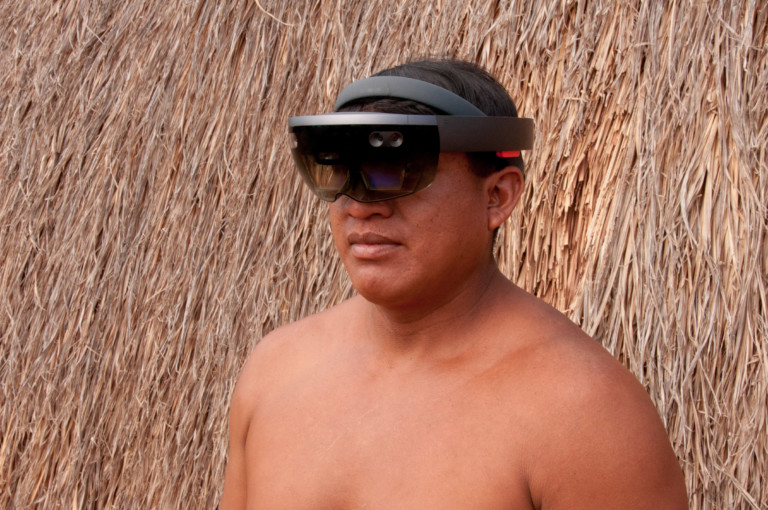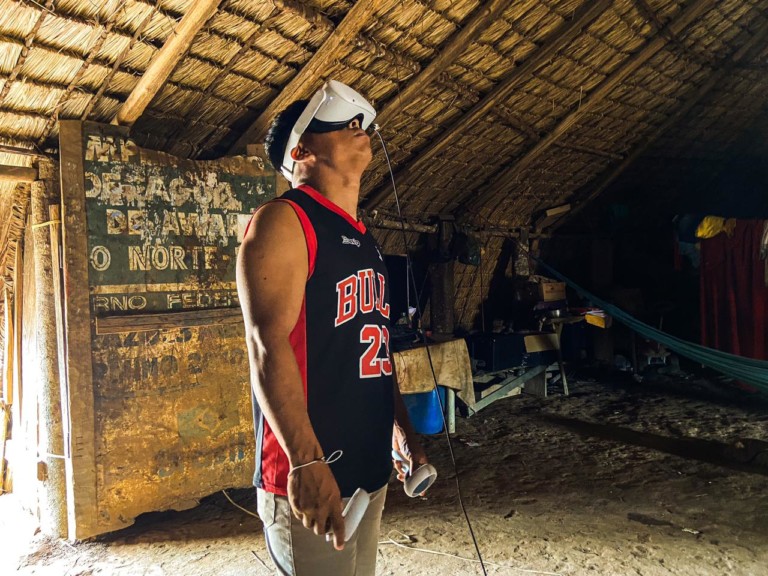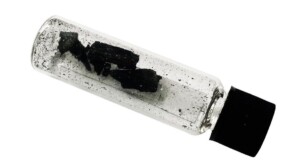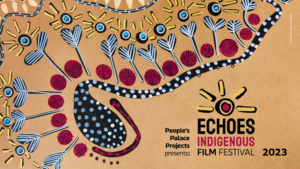Kamukuwaká VR: Visiting a Sacred Cave
Giving the Wauja Indigenous people the experience of visiting their most sacred Xingu through virtual reality.

Project Overview
People’s Palace Projects associated artist Nathaniel Mann and the Indigenous Association Tulukai (AIT) worked collaboratively to develop an innovative virtual reality interface to the cave of Kamukuwaká.
The technology offers old and new generations of indigenous people a chance to travel back to the sacred cave, which is considered to be their “book of learning”: an archaeological site that holds Wauja’s beliefs, customs and history.
In 2018, this ancient decorated cave – thought to be the most important historical and spiritual site for the Wauja and the other 15 indigenous peoples in the Xingu territory – was violently desecrated by an unknown assailant. The destruction is likely to be a result of the ongoing tension between indigenous and farming communities in the state of Mato Grosso, in Brazil. (BBC News story, in Portuguese)
Learning with VR
By using VR devices, about 700 Indigenous people are now able to learn about the ancestral knowledge that was engraved in Kamukuaká’s rock-art panels without leaving their village.
To make it possible, in this remote area of Brazil, four indigenous villages were equipped with computers and solar panels to provide online connectivity. The whole experience has been documented in the Wauja villages by teacher and filmmaker Piratá Waura. They hope to share this technology with the other 15 indigenous peoples of Xingu in the near future.

From Xingu to Copenhagen and Paris
The Kamukuawaká VR experience and mixed-reality installation have been selected by CPH:Lab Inter symposion as part of the CPH: DOX film festival that took place from in April, 2022 in Denmark. Nine immersive projects, including Kamukuwaká, explored and interrogated the subject of ‘Transformations’.
The prototype was also showcased at UNESCO’s headquarters in Paris, in December 2022, during the official High-level launch event of the International Decade of Indigenous Languages where Indigenous leaders, investors and UN member states/diplomats had a chance to experience a taster of the Kamukuwaká VR.
The Partnership
This project is a result of a well-established relationship between the Wauja Community, PPP and Factum Foundation that started in 2018. In September that year, an expedition to the sacred cave of Kamukuwaká organised with members of the Wauja community, specialists from Factum Foundation and an independent team of Brazilian anthropologists, found its ancient petroglyphs had been systematically destroyed. In a groundbreaking undertaking, the Wauja led an international network of organisations, academics, and volunteers to create a meticulous digital restoration of their sacred engravings.
Drawings of the Kamukuwaká by the indigenous people, existing photos and the scanning of the site were digitally documented by a team of international artists and technologists. In the Factum Foundation studio in Madrid, they turned the gathered information into an impressive 3D eight-metre long replica of the cave, securing the sacred engravings for future generations. You can read details of this project here, and a publication can be downloaded here.
PPP is hoping to ship the full size replica from Spain to the Xingu Indigenous territory in Spring 2024.
The next step
Piratá Waurá - Wauja Filmmaker and Educator
We are working on a script and storyboard for a new experience while we seek more funds to develop a prototype. The new VR will explore the pressing issues of climate justice and Indigenous resilience in the Amazon through the lens of Kamukuwaká myth for non-Indigenous audiences, to be launched at COP30 in Para. The experience can then be taken to galleries, museums, schools, universities and conferences around the world.
The Kamukuwaká story is a symbol of Xingu defiance that will draw international attention to the existential threats Indigenous communities face in the Amazon region.


